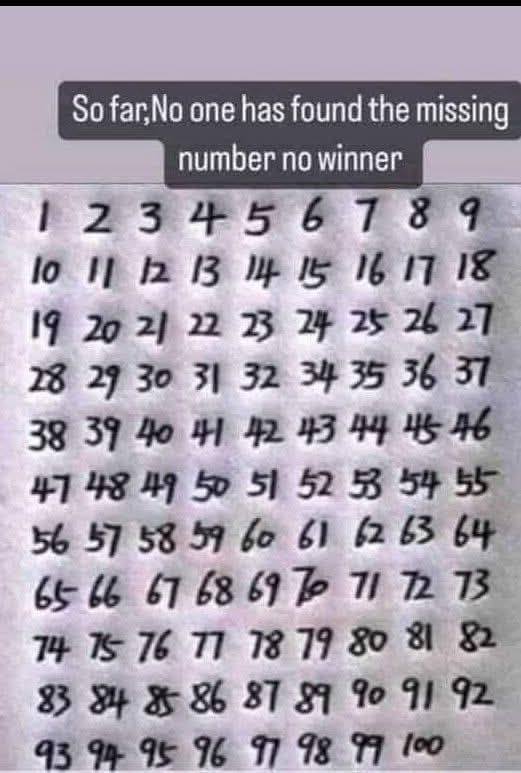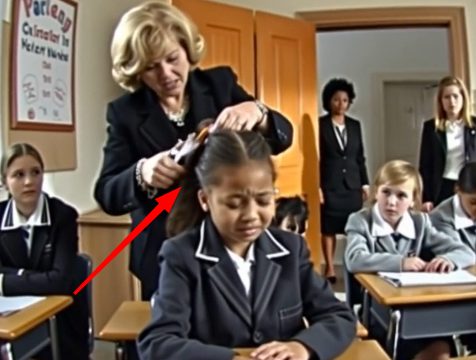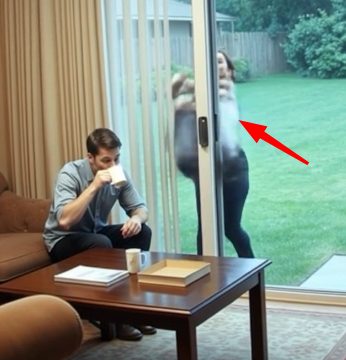In a world where our attention spans are getting shorter and we’re constantly swiping, scrolling, and double-tapping through endless content, a simple puzzle has managed to stop people in their tracks—and leave them scratching their heads. It all starts with a grid of numbers, laid out in a neat and seemingly perfect sequence from 1 to 100. But there’s a catch, and it’s got everyone talking.

At first glance, this numerical puzzle looks like any ordinary number chart you might see in an elementary school classroom. All the numbers appear to be there, running row by row in order. But sitting above the grid is a bold challenge: “So far, no one has found the missing number. No winner.” That one sentence is enough to turn a casual glance into a full-on investigation.
So, naturally, you start scanning the grid. Maybe you read the numbers out loud, maybe you track them row by row with your finger. Some people even take out a pen and start checking them off. But even after a thorough inspection, most walk away scratching their heads, unable to figure out what’s wrong.
Here’s the twist: the missing number isn’t a result of a break in the numerical order—it’s all about visual misdirection. Instead of a missing slot or a blank space, the grid actually includes every number except one. And what makes it even harder? There’s a duplicate. That’s right. The number 76 appears twice in the grid, which cleverly covers up the absence of another number—70.
That’s what makes this brain teaser so effective. It’s not just testing whether you know how to count. It’s challenging your ability to focus, observe patterns, and catch tiny discrepancies in a sea of familiar data. When our brains see numbers arranged in a structured format like a 10×10 grid, we tend to assume everything is in order. Our minds skip over details that feel repetitive or expected. That’s why most people completely overlook the fact that 70 isn’t there.
It’s a psychological trick, one that plays on how we process visual information. Our brains are wired to identify major differences, not subtle swaps or repetitions. When there’s no glaring hole or empty spot, we assume nothing is missing. And when something familiar—like a number between 1 and 100—shows up twice, we often don’t even notice, because the duplicate fits right in with what we expect to see.
That’s the genius of this puzzle. It’s a lesson in slowing down. In today’s fast-paced digital world, we’re constantly rushing through information. We consume content at lightning speed—skimming articles, scrolling past videos, and barely noticing the details. But this number grid demands your full attention. It challenges you to pause, observe, and truly focus.
The puzzle has gone viral on social media, sparking debates, reactions, and plenty of “aha!” moments. Some people feel frustrated when they can’t spot the missing number right away. Others feel a sense of victory when they finally realize that 70 is gone and that 76 shows up twice. It’s a small detail, but once you see it, you can’t unsee it.
So why do puzzles like this capture our attention so effectively? For one, they tap into our natural curiosity. We like to be challenged. We enjoy proving we’re observant or clever enough to solve something others can’t. And puzzles like this one offer just the right mix of difficulty and simplicity. They look easy, but they’re tricky enough to stump even the most careful observers.
More than anything, though, this puzzle serves as a reminder. In a world that moves fast, it pays to slow down. Taking a second look can make all the difference—not just in solving puzzles, but in everyday life. Whether it’s reviewing a document, double-checking a receipt, or just being more mindful, paying closer attention can help you catch things others miss.
So, did you find the missing number on your own, or did it take a little nudge? Either way, you’re not alone. Most people never notice it the first time around. But once you do, it’s a fun and satisfying discovery. And next time you see a simple puzzle online, you might just look a little closer.





